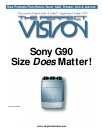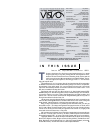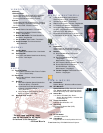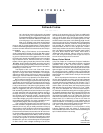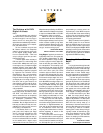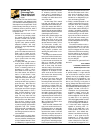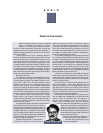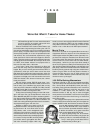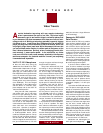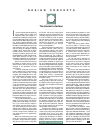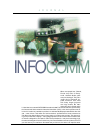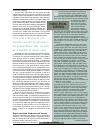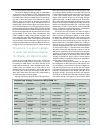
The Problem with DVD:
Digital Artifacts
E d i t o r :
I have subscribed to your revival of
The Perfect Vi s i o n, and not being famil-
iar with the original, I can only say you
seem to be off to a strong start. Yo u r
style feels more academically, intellectu-
ally driven than some of your competi-
tion, and I welcome this.
I’d like to address one point that
M r. Pearson makes in his Vi e w p o i n t s
editorial. “And we shall push, push, push
for the highest quality images, either
from an ‘enhanced’ DVD...” How hard
are you willing to push? Are you satis-
fied with DVD now?
I find the digital motion artifacts of
DVD too severe for a serious High End
format. DVD’s 10Mbps data rate is just
not enough to carry a component digital
standard definition video signal! Wi t h
only few exceptions, every DVD I watch,
on a wide variety of systems, is plagued
by large-area low luminance chroma
macroblocking. Also, pre-compression
noise reduction removes much of the
film grain within the image. Film grain is
an integral part of an image; the type of
film stock and its grain structure are
often aesthetic choices made by direc-
tors of photography. How can reduction
or removal of this element be aestheti-
cally acceptable?
The popular press, and even some
higher end journals, are head over heels
over DVD. I will admit that it offers
some true benefits such as component
color space, progressive output capabil-
i t y, anamorphic presentation, and
extended luminance/chroma channel
bandwidth. But the digital artifacts are
bad, they are visible, and they are unac-
ceptable. But I hear no other voices to
the contrary. This saddens me.
If The Perfect Vi s i o n is to “push,
push, push,” then I implore your maga-
zine to [convince] manufacturers that
our future digital formats must use
milder data reduction methods. I fear for
the future “enhanced DVD” format. Wi l l
we be saddled with a digital output
channel that will max out at the low 19
Mbps data rate specified by the ATSC for
1080i transmission? Wo u l d n ’t it be better
to output a wideband RGB or Y/R-Y/B-Y
analog signal to feed our monitors?
Within the home, we should shoot
for performance above the AT S C / G r a n d
Alliance system and stay free of injurious
motion artifacts caused by high data-
reduction schemes. Please use your plat-
form to strive for the finest images we
can get – we are counting on you!
CHRISTOPHER MOORE
M A N H AT T AN BEACH, CALIFORNIA
Greg Rogers: I applaud your desire for
high-quality video, but I can’t agree with
your sweeping generalization of DVD.
You haven’t provided a single example
of a disc or player for which “digital arti-
facts are bad, they are visible, and they
are unacceptable.” That certainly is not
the case with the vast majority of DVDs
I buy or the players I use today. Early on
there were some quite poor DVDs
rushed to market to make a quick buck
and some DVD players that were ques-
tionable in terms of MPEG artifacts and
D/A converter output stages. Your char-
acterization would have applied to
them. But MPEG encoding on major stu-
dio releases is generally quite good
today and MPEG decoding and signal
processing in players is excellent. That
said, there are still plenty of video quali-
ty problems on DVD, but I think you are
barking up the wrong tree. I would spare
you the usual advice to make certain
your displays are calibrated, but I have
no other explanation for what you see.
I believe if we want real improve-
ments in DVD quality, we must have bet-
ter transfers using high-definition down-
conversion, no edge-enhancement arti-
facts, and use the 16.9 enhanced format
for all widescreen movies. And stop
recycling old transfers done on inferior
telecine equipment or stored on D-2
composite video VTRs.
I’m not sure how much film-grain
you have been able to see through dirty
film transfers and the video noise of pre-
vious formats like laserdisc, and forgive
me, VHS tape. But you are correct that
pre-processing to remove noise is an
important part of the MPEG compres-
sion process. But if that means cleaning
up dirt on film, and using better telecine
equipment with less noise, then I think
i t ’s a pretty good tradeoff.
When it comes to future high-defin-
ition DVD formats I’m not as worried
about the ATSC bit-rates as I was a year
ago. From what I’ve seen of pre-record-
ed HDTV, multiple-pass MP@HL MPEG
encoding is working well and encoders
will be even better by the time 720p gets
to DVD. The jury is still out on real-time
high-definition MPEG encoding.
Targeting 14-Year-Old
Boys?
Editor:
I’ve just skimmed through Issue 24,
and already TPV is better than just about
anything else out there. A few weeks ago
a friend and I were discussing the lam-
entable state of Home Theater m a g a-
zine, which apparently has decided that
its target audience is 14-year-old boys.
…I’m now using one of the Panan-
sonic DVD players, which does a pretty
good job. My monitor is the Toshiba 35-
inch direct view, and I heard that the
Sony DVD player looks a little soft when
not in 16.9 enhanced mode (although
that appears not to be a problem with
the S7700). I’d be tempted to spring for a
Theta Voyager if I had 6 grand to spare!
I’ve seen all the films in your “Best
of 1998” list except Central Station,
Gods and Monsters, Elizabeth, and T h e
Object of My Affection. I’ve been pleas-
antly surprised to see that the library of
DVD films isn’t entirely made up of
blockbusters. I had never seen Picnic at
Hanging Rock before and was knocked
for a loop by it. What an incredible,
haunting film! I’ve also been picking up
a goodly number of laserdiscs at give-
away prices. Speaking of which, is DTS
a consumer failure? I see that Ken
C r a n e ’s is dumping its DTS laserdiscs,
which can’t be a good sign.
RICHARD GALLAGHER
RGALLAGH@IX. NETCOM.COM
L E T T E R S



